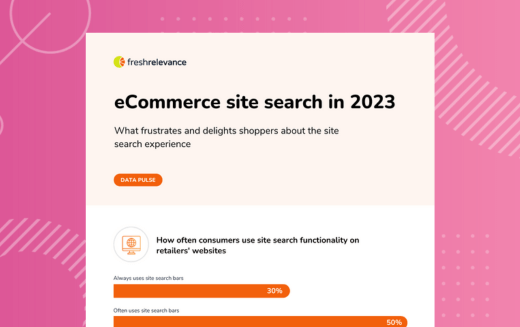eCommerce site search in 2023

Website visitors are often hard won. Whether it’s through PPC, social media ads or the time and effort spent on optimizing your site for search engines, website traffic comes at a price. So it makes sense to ensure that all elements of your website are optimized to deliver a customer experience that converts. Optimizing your site search capability is a big part of this, since shoppers who conduct site searches often have high purchase intent. And with convenience being a key component of a good customer experience, it’s important to make it as easy as possible for shoppers to find what they are looking for fast.
But what makes for a good eCommerce site search experience? Together with Censuswide, we polled 2000 consumers across the UK to find out what frustrates and delights shoppers about the site search experience and how a negative site search experience can hurt your business.
Key takeaways:
- Getting the site search experience right should be a key priority for eCommerce businesses, with 68% of consumers saying they use the search functionality on retailers’ websites, 30% of those consumers saying they always use site search bars and 24% saying they would stop shopping with a retailer that provides a poor search experience.
- Relevancy is key when it comes to site search, with 33% of consumers saying they find it frustrating when their search results are irrelevant and 24% getting frustrated when the results show out of stock items.
- Consumers want control over their site search experience, with 33% saying they are more likely to engage with search results when they can use filters and 28% saying they get frustrated when a long list of results appears with no option to narrow it down through filters.
- Consumers don’t want to do all the work, though. They want their site search experience to be smart. 26% want their search results to include items that are synonymous with their query, 24% want to be shown search query suggestions and 20% want to be shown alternative products when their search brings back no results.
How often consumers use site search functionality on retailers’ websites
Of the 68% of consumers who said they use the search functionality on retailers’ websites, almost 1 in 3 said they always use site search bars. 1 in 2 consumers often use site search bars, while 17% occasionally use them and only 2% rarely use them.
What consumers want from the site search experience
Consumers want control over their site search experience, with 1 in 3 consumers citing the availability of filters as a factor that makes them more likely to engage with the results from their search query.
Retailers should also consider the visual elements of their site search experience, since almost 1 in 3 consumers say they are more likely to engage with their search results when images are included.
Finally, consumers want the site search experience to be smart and intuitive. More than 1 in 4 are more likely to engage with their search results when items that are synonymous with their query are included in the results (for example when they search for ‘sweaters’ they are also shown results for ‘jumpers’). Similarly, almost 1 in 4 consumers say search query suggestions are likely to encourage them to engage with the search results (for example, when they type ‘photo frames’ into the search box, they’re shown the option to search for ‘photo frames 4×4’ or ‘photo frames for walls’), and 1 in 5 consumers want to see alternative products when their search brings back no results.
What frustrates consumers about the site search experience
Unsurprisingly, relevancy is key when it comes to not avoiding frustrations, since 1 in 3 consumers say they get frustrated when the search results are irrelevant. Similarly, almost 1 in 4 consumers get frustrated when the results show out of stock items.
As we saw in the previous section, control is also important to consumers; more than 1 in 4 consumers get frustrated when there is no option to filter the results.
More than 1 in 4 consumers get frustrated when no results appear, so as mentioned in the previous section, it’s important to show alternatives when a search query yields no results.
Consumers also want to avoid waiting around, since 1 in 5 say they get frustrated when the results take too long to appear.
The impact of shopping with retailers who provide a poor search experience
The impact of providing a poor search experience can’t be understated – almost 1 in 4 consumers would stop shopping with a retailer who provides a poor search experience and almost half of consumers would be more likely to switch to another retailer in the future. Only 16% of consumers wouldn’t mind. This means it’s crucial for retailers to follow site search best practices to ensure they keep customers on their site and increase conversions.
Download the infographic to view and save all the data visualizations shown here in one place.
Copyright © Fresh Relevance. You are welcome to reuse this data on public websites, provided it is attributed to Fresh Relevance and has a link to this page, for example: Data from Fresh Relevance Ltd.
